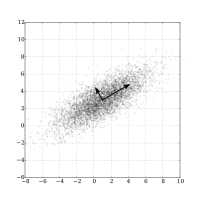
Photo from wikipedia
The local signal-to-noise orthogonalization algorithm has been widely used in the community of seismic processing and imaging. It helps orthogonalize the signal-and-noise components in an elegant way so that the… Click to show full abstract
The local signal-to-noise orthogonalization algorithm has been widely used in the community of seismic processing and imaging. It helps orthogonalize the signal-and-noise components in an elegant way so that the noise does not contain the signal leakage in seismic denoising. The traditional local signal-to-noise orthogonalization is based on solving a highly underdetermined, ill-posed inverse problem with local smoothness constraint. Due to the inversion nature, the local orthogonalization method requires a large number of iterations and thus is computationally demanding in large-scale applications. Here, we proposed a much accelerated signal-and-noise orthogonalization method, where we design an efficient way for calculating the orthogonalization weight. When new samples are involved in the calculation, we calculate the orthogonalization weight of the new samples by connecting them with the calculated weights of the previous samples. The orthogonalization weight needs to be smoothed and scaled after all samples have been processed to make the resulted orthogonalization weight smooth across the seismic data and match the amplitude level of the initially suppressed noise. In this way, we avoid iterations when calculating the orthogonalization weight. We apply the proposed method to several synthetic and field data examples, have a benchmark comparison with state-of-the-art algorithms, and demonstrate its much accelerated efficiency compared with the traditional local signal-and-noise orthogonalization.
Journal Title: IEEE Transactions on Geoscience and Remote Sensing
Year Published: 2022
Link to full text (if available)
Share on Social Media: Sign Up to like & get
recommendations!